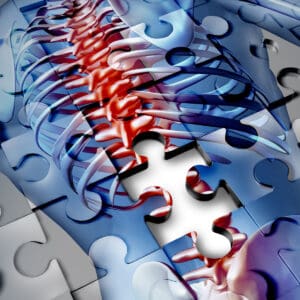Snellings Law PLLC Attorneys are
Dependable Spinal Cord Injury Lawyers Committed to Helping You
Spinal Cord Injuries
Spinal cord injuries are one of the most common injuries that we see in car accident victims. Whether it be whiplash type injuries, disc injuries, or even more severe spinal cord injuries causing paralysis, we have helped personal injury victims navigate their treatment and insurance claims process. What may start out as soreness and stiffness can often times develop into numbness and tingling in hands and feet.
Spinal cord injuries are often not apparent right away. We have had more clients than we can count who have left the scene of a car accident thinking they were fine, only to not be able to get out of bed the next morning or to even start developing symptoms several days later. Since back injuries can lead to a lifetime of pain or reduced motion, we take them seriously at Snellings Law.

Some of the most common types of spinal injuries we see are as follows:
Whiplash Injuries – Whiplash occurs when your neck is forcibly bent forward then backward or backward then forward.1 In the car accident scenario, this usually occurs when a driver or passenger experiences sudden acceleration (rear-impact) or sudden deceleration (frontal-impact).
Herniated, Bulged, Slipped, and Ruptured Discs – The bones in our spine are called vertebrae, and between each vertebra is a disc. These discs support and cushion the vertebrae to prevent bone grinding on bone. A herniated disc (also called bulged, slipped, or ruptured) means the interior of the disc has come through the outer layer of the disc and into the spinal canal. Since the spinal canal is a very narrow area, this fragment can push on the spinal cord causing pain, numbness, tingling, and other symptoms.
Spinal Fractures – Fractures to the vertebrae can occur anywhere along the spine. These fractures can pinch, compress, or tear the spinal cord. The most common type of fracture we see in car accident and truck accident cases are compression fractures. A sudden downward force shatters and collapses the body of the vertebrae.2 This type of fracture can throw bone fragments into the spinal canal and damage the spinal cord, which would then be called a burst fracture.
Spinal Cord Injuries – Car accidents are the leading cause of spinal cord injuries in younger Americans. A complete spinal cord injury causes a total loss in all motor and sensory function below the level of the injury. An incomplete spinal cord injury leaves some function below the level of injury.3 The American Spinal Injury Association created a scale to classify the severity of the injury4:
- ASIA A – injury is complete spinal cord injury with no sensory or motor function preserved;
- ASIA B – A sensory incomplete injury with complete motor function loss;
- ASIA C – a motor incomplete injury, where there is some movement, but less than half the muscle groups are anti-gravity (can lift up against the force of gravity with a full range of motion);
- ASIA D – a motor incomplete injury with more than half of the muscle groups being anti-gravity;
- ASIA E – normal
The more severe the injury, the less likely a recovery will occur. For more information about types of spinal cord injuries, spinal cord injury signs and symptoms, and what to do if you think you’ve suffered a spinal cord injury, check out this video:
We work with our clients to document their injuries and take our time to make sure our clients have plenty of time to navigate their treatment plan with their physicians before we even begin to think about negotiating their claims. We want to know our clients have been thoroughly diagnosed and treated with the very best care before beginning the demand process. That is the only way to ensure that we fully evaluate their claim and obtain the best possible claim result for them.
All we do at Snellings Law is personal injury. If you or a loved one has been recently injured in a severe accident, don’t hesitate to give us a call. At Snellings Law, we fight for our clients to get the treatment they need and help them obtain their full settlement. Our team of award-winning trial lawyers are dedicated to helping victims with catastrophic injuries across North Texas. If you are suffering a spinal cord injury due to the negligence of someone else, we can help., Give us a call at 214-387-0387 and set up a free strategy session with one of our spinal cord injury attorneys today to discuss your next steps.

Frequently Asked Questions
Has an auto accident left you or a loved one grappling with a spinal cord injury? Understanding the causes, symptoms, and treatments can feel like navigating a complex maze. But fear not! We have answered several frequently asked questions here.
The spinal cord runs from the base of your brain to your lower back. A spinal cord injury results from damage to any part of the spinal cord or nerves at the end of the spinal canal. This often leads to permanent alterations in strength, sensation, and other bodily functions below the injury site.
Spinal cord injuries in auto accidents can occur due to sudden, blunt-force trauma. Such trauma might include the impact of a collision, the body being violently thrown around, or debris penetrating the spine. Typically, we see more severe spinal cord injuries in crashes with significant force, such as high-speed, rollover, and head-on car accidents.
Symptoms can vary depending on the severity and location of the injury but may include pain, numbness, paralysis, incontinence, difficulty walking, or loss of control over body movements. Some spinal cord symptoms may not be felt immediately but develop several days after the accident.
A diagnosis typically involves a physical examination and imaging tests such as X-rays, CT scans, or MRIs. Additional tests like a myelogram or nerve conduction study might be required in certain cases.
Treatment for spinal cord injuries often involves immediate emergency care followed by ongoing rehabilitation. This might include surgery, medication, physical therapy, occupational therapy, and other supportive treatments.
We would love to tell you YES!, but it oftentimes depends on the circumstances. The personal injury process in Texas can be very complicated, depending on several factors. Typically, if the accident was caused by someone else’s negligence, you would be able to seek compensation for your medical bills, lost wages, pain and suffering, and other related costs.
There is no one-size-fits all damages scale. Each case is evaluated independently based on multiple factors. An adjuster or a jury will look at things like the severity of your injury, the cost of your medical treatment, your lost earnings, and other factors like how the injury has affected various aspects of your life and day-to-day activities.
The “statute of limitations” varies by state. You have as little as two years from the accident date in Texas to file a lawsuit. It’s crucial to consult with a personal injury attorney as soon as possible to ensure you don’t miss deadlines!
Please note: This FAQ is intended as a general overview and does not serve as legal advice. If you’ve suffered a spinal cord injury in an auto accident, it’s critical to consult with an attorney for guidance based on your unique circumstances.
Free Strategy Session Reveals How To Avoid the Traps Insurance Companies Set for Victims to Destroy Claims.
How it works:
- Call us now or give us your basic information in the Free Strategy Session box
- If your case is something we cannot help you with, we will do our best to get you the information of someone who can.
- If we can potentially help you, we will schedule a Free Strategy Session
There is zero obligation. We want all injury victims to understand their rights and the process.
After your Free Strategy Session, you will understand where insurance companies can set traps for you and what needs to be done to avoid these traps. You will also understand the personal injury process as well as how we can help, or if you need the help of an attorney. The strategy session typically will have one of three outcomes. You:
- Decide to move forward with our law firm.
- Decide to think about it, and we will be available to answer your questions.
- Say, “I’ve got this,” and decide you do not need an attorney.
Again, there is zero obligation and you will be informed and understand your rights and the process. We want to arm you with knowledge to avoid the traps insurance companies set to harm your claim.

